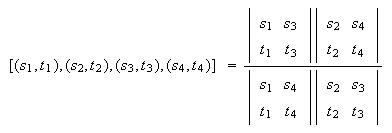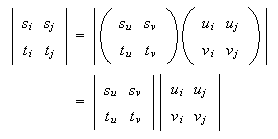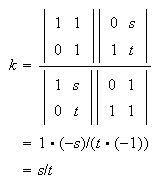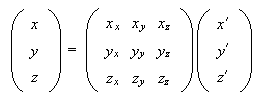CHASLES' THEOREM
By Hubert Shutrick
1. Pencils of Lines
Let fs = asx + bsy + c and ft = atx + bty + c where
sfs + tft = 0,
and these lines form a pencil of lines with base fs, ft. For

are linearly dependent using the common point, and, since the first two rows are independent, the last row must be a linear combination of the first two. Hence,
2. Change of Base
If
| fu | = su fs + tu ft | |
| fv | = sv fs + tv ft | |
give two distinct lines of the pencil, then fu, fv can be a new base.
| ufu + vfv | = u(su fs + tu ft) + v(sv fs + tv ft) | |
| = (usu + vsv)fs + (utu + vtv)ft. | ||
The transition from (u, v) to

It is important to note that the base is determined by fs, ft but not by the lines
3. Cross-ratio
In terms of the homogeneous parameters for the pencil, the convenient definition of cross-ratio is

It agrees with the one parameter version if the parameter is replaced by s/t.
Its importance in this context is that it is depends only on the four lines and not on the choice of homogeneous parameters. This becomes obvious using that the determinant of the product of two matrices is the product of the determinants:

If three different points are given along with the cross-ratio k of them with a forth point, then the forth point is uniquely determined. To prove this, choose the base so that the points have parameters

4. Projective Plane
The projective plane is obtained from the ordinary Euclidean plane by adjoining an extra point for each pencil of parallel lines. It is the point 'at infinity' where the lines of the pencil meet. To accommodate the new points it is convenient to introduce homogeneous coordinates. This is done by replacing the usual
A line in the plane is given by an equation

meet at (b, -a, 0) as required.
The line joining points
s(xs, ys, zs) + t (xt, yt, zt)
is on the line for each

This can be rewritten

The parameters for the line are the parameters for the pencil of lines through
5. Change of Coordinates
The coordinate vectors X = (1, 0, 0),
| X' | = (xx, yx, zx) | |
| Y' | = (xy, yy, zy) | |
| Z' | = (xz, yz, zz) | |
are not collinear, then they can form a new base:
(x, y, z) = x'X' + y'Y' + z'Z'.
In matrix form

The matrix is invertible since the points are not collinear.
Note that the points defined by
| X' | = xx X | |
| Y' | = yy Y | |
| Z' | = zz Z | |
defines a new base with the same base points if
6. Chasles' Theorem
The theorem states that,
for four points on a non-degenerate conic, the cross-ratio of the pencil of four lines from a fifth point of the conic to the given points does not depend on the choice of the fifth point.
To prove this choose a coordinate system such that X and Y are points of the conic, Z is the intersection of the tangents from X and Y and the
ax² + by² + cz² + fyz + gxz + hxy = 0.
Since the line y = 0 is tangent at
xy = z².
Consider the pencil of lines through X with base
(Chasles' theorem leads to an elegant projective proof of Pascal's Theorem. Also, there is another proof of Chasles' Theorem and a third, the simplest of all.)
Chasles' Theorem
- Chasles' Theorem
- Chasles' Theorem, a Simple Proof
- Pascal's Theorem, Homogeneous Coordinates
- Chasles' Theorem, a Proof
- Projective Proof of Pascal's Theorem
|Contact| |Front page| |Contents| |Geometry|
Copyright © 1996-2018 Alexander Bogomolny73581890
